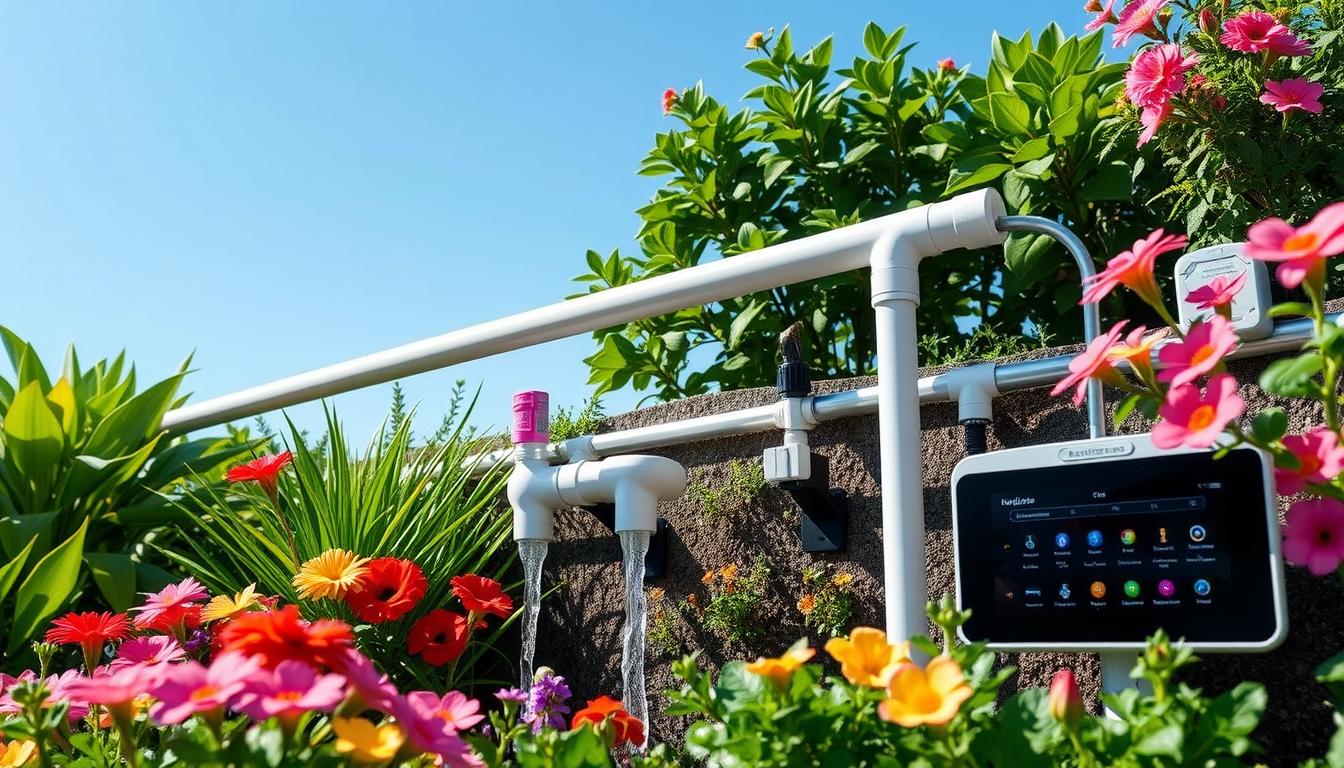Welcome to our comprehensive guide on setting up an automated garden irrigation system. This setup can significantly save you time and water. With the right systems, your plants will receive the perfect amount of water. This not only reduces waste but also cuts down on your water bill. A well-designed watering setup is crucial for a healthy garden.
An automated garden irrigation system can make this possible. By delivering water directly to your plants’ roots, it minimizes evaporation and runoff. This makes your watering more efficient.
Introduction to Automated Irrigation
In this article, we’ll explore the benefits of automated irrigation systems, their essential components, and how to set them up and maintain them. Whether you’re an experienced gardener or new to the field, this guide will equip you with the knowledge to create a water-efficient garden. We’ll discuss various irrigation systems and help you pick the best one for your garden.
Key Takeaways
- Automated irrigation systems can save time and water
- A well-designed watering setup is essential for a thriving garden
- Irrigation systems can help reduce waste and save money on water bills
- Automated garden irrigation systems can be customized to fit your garden’s needs
- Proper maintenance is necessary to ensure the system works efficiently
Understanding Garden Irrigation Systems and Their Benefits
Garden irrigation systems are crafted to deliver the perfect amount of water to plants, cutting down on waste and fostering healthy growth. By employing drip irrigation and sprinkler systems, gardeners can achieve significant water savings. Recent statistics reveal that automated irrigation systems can slash water usage by up to 50% compared to traditional methods.
Automated watering systems bring numerous advantages, including less evaporation and runoff. This is crucial in water-scarce regions, as it minimizes waste and ensures plants get the water they need. For instance, drip irrigation delivers water directly to the roots, reducing evaporation and runoff.
Types of Automated Irrigation Systems
There are various automated irrigation systems available, including drip irrigation and sprinkler systems. Drip irrigation is highly efficient, delivering water directly to the roots. Sprinkler systems, on the other hand, are ideal for larger areas and can be programmed to water at specific times.
Key Benefits of Automated Watering
Automated watering systems offer several key benefits, including:
- Water efficiency: These systems help reduce water waste and promote healthy plant growth.
- Convenience: They can be programmed to water at specific times, making garden maintenance easier.
- Cost savings: By reducing water waste and promoting healthy growth, these systems can help gardeners save on water bills.
Water Conservation Advantages
Automated irrigation systems have several water conservation benefits, including reduced evaporation and runoff. By using drip irrigation and sprinkler systems, gardeners can conserve water and promote healthy plant growth.
| System Type | Water Efficiency | Cost Savings |
|---|---|---|
| Drip Irrigation | High | Yes |
| Sprinkler Systems | Medium | Yes |
Essential Components for Your Irrigation Setup
Setting up an automated irrigation system requires careful consideration of several key components. These elements work in harmony to create a irrigation system that is both efficient and effective. A standard irrigation system includes a controller, valves, pipes, and sprinklers or drippers.
When selecting components for your automated systems, consider your garden’s size and layout, as well as the types of plants you’re watering. Here are some critical components to think about:
- Controller: This is the heart of your irrigation system, responsible for controlling water flow.
- Valves: These manage water distribution to various parts of your garden.
- Pipes: They transport water from the source to the sprinklers or drippers.
- Sprinklers or drippers: These are responsible for watering your plants.
Choosing the right components for your irrigation systems and automated systems is crucial. It ensures your system is both efficient and effective. This approach helps save water, reduces environmental impact, and keeps your garden healthy and vibrant.
When selecting components, consider factors like water pressure, flow rate, and compatibility. Researching and choosing the correct components will help you create an automated system tailored to your needs. This system will aid in achieving your gardening objectives.
| Component | Description |
|---|---|
| Controller | Regulates water flow and scheduling |
| Valves | Control water flow to different areas |
| Pipes | Carry water from source to sprinklers or drippers |
| Sprinklers or Drippers | Distribute water to plants |
Planning Your Garden Irrigation System Layout
For efficient garden watering, a well-thought-out layout is essential. Measuring your garden space is the first step. This helps you place irrigation system components for even water distribution.
Creating irrigation zones is a critical planning aspect. It involves dividing your garden into areas with different watering needs. This approach reduces water waste and promotes plant health.
Measuring Your Garden Space
Begin by sketching a diagram of your garden, noting plant and feature locations. Record each area’s dimensions, considering obstacles. This will guide you in designing a tailored watering setup.
Water Source Considerations
When planning your irrigation system, consider your water source. Wells or rainwater systems require a system that efficiently uses available water. A well-planned layout ensures your garden’s long-term health and beauty.
Selecting the Right Irrigation Method
Choosing the right irrigation method for your garden is crucial. Each option has its own set of benefits and drawbacks. The ideal choice depends on your specific plants and garden conditions. Drip irrigation systems, for instance, are perfect for plants needing frequent watering. They deliver water directly to the roots.
Sprinkler systems and soaker hoses are also popular. Sprinkler systems are ideal for large areas and can be programmed. Soaker hoses are great for watering plants that are close together. Here are some key considerations for each method:
- Drip irrigation: efficient, reduces evaporation, and minimizes runoff
- Sprinkler systems: covers large areas, easy to install, and can be programmed
- Soaker hoses: easy to install, flexible, and perfect for small gardens
The right irrigation method depends on your specific needs and garden conditions. By considering water usage, plant type, and garden size, you can choose the best method. This will help you enjoy a lush, healthy landscape.
| Irrigation Method | Benefits | Drawbacks |
|---|---|---|
| Drip Irrigation | Efficient, reduces evaporation | Can be expensive to install |
| Sprinkler Systems | Covers large areas, easy to install | Can be wasteful if not programmed correctly |
| Soaker Hoses | Easy to install, flexible | May not be suitable for large gardens |
Installation Steps and Requirements
Installing irrigation systems requires careful adherence to the manufacturer’s guidelines. This approach prevents common errors and ensures your automated systems operate at peak performance.
Begin by collecting all required parts, such as pipes, fittings, and controllers. Key steps include:
- Plan your irrigation system’s layout, considering your garden’s dimensions and shape.
- Excavate trenches for the pipes, ensuring they’re deep enough to withstand freezing and lawn mowers.
- Connect the pipes and fittings, ensuring all connections are tight and leak-free.
Remember, the type of irrigation systems you choose impacts the installation process. For instance, automated systems demand more intricate programming and setup.
By meticulously following these steps and considering your irrigation systems‘ specific needs, you’ll achieve a successful installation. This will allow you to fully appreciate the advantages of automated systems in your garden.
Setting Up Smart Controls and Automation
Automated systems can significantly boost your garden’s irrigation efficiency. Smart controls help optimize water use and cut down on waste. These systems adjust watering schedules based on weather, ensuring plants get the right water at the right time.
To start with smart controls, understanding timer programming basics is key. This involves setting up a schedule that considers soil type, plant needs, and climate. Automated systems make it easy to tweak this schedule as needed, ensuring your plants get the right water.
Timer Programming Basics
- Set up a schedule based on soil type and plant water requirements
- Adjust the schedule according to climate and weather conditions
- Use smart controllers to automate the process
Smart Controller Options
There’s a variety of smart controllers available, each with unique features and benefits. Popular choices include wireless, sensor-based, and weather-based controllers. When selecting a smart controller, consider ease of use, compatibility with your system, and weather adjustability.
Weather-Based Adjustments
Weather-based adjustments are vital in smart controls. They consider rainfall, temperature, and humidity to optimize irrigation schedules. This reduces water waste and ensures plants receive the right amount of water. With automated systems and smart controls, you can maintain a healthy garden while minimizing environmental impact.
Maintenance and System Care
Regular maintenance is key to extending your irrigation systems’ lifespan. Seasonal maintenance tasks are essential for efficient operation. This includes cleaning and inspecting to prevent clogs and damage.
Winterization is also crucial to avoid damage from freezing. It involves draining the system and insulating exposed pipes to prevent bursting.
Seasonal Maintenance Tasks
- Clean and inspect the system regularly
- Check for leaks and damaged pipes
- Replace worn-out or damaged parts
Winterization Process
Winterization is a critical step in maintaining your irrigation systems. It involves:
| Step | Description |
|---|---|
| Drain the system | Remove all water from the pipes to prevent freezing |
| Insulate exposed pipes | Use insulation materials to protect pipes from freezing temperatures |
| Disconnect and drain hoses | Remove and drain hoses to prevent damage |
By following these maintenance tips, your irrigation systems will continue to function efficiently. This ensures your garden receives the right amount of water to thrive.
Troubleshooting Common Issues
Dealing with irrigation systems often involves troubleshooting. Issues like clogged nozzles and faulty valves can cause problems. These problems can lead to reduced water pressure, uneven water distribution, and increased water waste.
To tackle these problems, identifying the root cause is key. Here are some steps to follow:
- Inspect the system for any blockages or debris
- Check the valves and nozzles for any signs of damage or wear
- Verify that the water pressure is within the recommended range
By following these steps, you can quickly identify and resolve common issues with your irrigation systems. This ensures your garden or lawn gets the right amount of water at the right time. Troubleshooting is an ongoing process that requires regular monitoring and maintenance to prevent issues from arising in the first place.
Regular troubleshooting can extend your irrigation systems‘ lifespan, reduce water waste, and save money on your water bill. Being proactive and addressing issues promptly allows you to enjoy a healthy, thriving garden or lawn. It also minimizes your environmental impact.
Some common issues and their solutions are presented in the table below:
| Issue | Solution |
|---|---|
| Clogged nozzles | Clean or replace the nozzles |
| Faulty valves | Replace the valves |
| Low water pressure | Check and adjust the water pressure regulator |
Conclusion: Maximizing Your Garden Irrigation Investment
Our guide on setting up an automated garden watering system has shown its value. A well-designed irrigation system can save you time, money, and water. By planning your garden layout, choosing the right equipment, and using smart controls, you can achieve a highly efficient watering solution. This solution will keep your plants healthy without much effort from you.
The initial cost of an automated irrigation system may seem high. Yet, the long-term savings on water and utility bills make it a smart investment. You’ll also enjoy the peace of mind knowing your garden is always watered, even when you’re away. So, invest in an automated garden irrigation system today. Your plants and your wallet will appreciate it!


